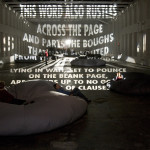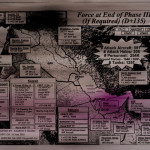By MATTHEW NASH
With Projections, Jenny Holzer has truly utilized the full potential of Mass MoCA's Building 5. Using relatively few elements -- light, text, oversized beanbag cushions -- she has created an experience that is equally intriguing, soothing and disorienting.
Upon entering the cavernous space, we are confronted with gigantic white words, scrolling across the floor and ceiling. Two projectors are mounted at either end of the room, and the words overlap and distort as they pass the length of the room, growing larger and harder to read, before passing back along the beams overhead. The floor is dotted with large beanbags that appear as both hills in a landscape or body-bags strewn across the ground. The disorientation created by the moving text makes the scale of the objects in the space hard to determine.
Walking through the gallery is equally as disorienting. The text moving across the floor might to be setting a pace for walking, yet it increases gradually as it grows larger and more distorted. The two layers of scrolling words meet in the center of the room, like waves colliding and washing over each other. The bean-bag cushions offer a moment of calm, though, islands in an ocean of moving text. They allow for time to read and contemplate the words, their meaning, and the experience of a space thoroughly transformed by light.
The text itself is vital to understanding the piece, and offers an important contrast to Holzer's prints on view in the next gallery. While it is hard to read very much of the poetry as it scrolls by, one catches phrases: "Nothing has changed / except there are / more people, / and new offenses / have sprung up beside / the old ones..."
The poems are from View with a Grain of Sand and Poems New and Collected: 1957-1997 by Wisława Szymborska, translated from the original Polish. The website of the Poetry Foundation describes Szymborska's poetry:
Explaining Szymborska's work, translator Stanislaw Baranczak noted in New York Times Book Review: "The typical lyrical situation on which a Szymborska poem is founded is the confrontation between the directly stated or implied opinion on an issue and the question that raises doubt about its validity. The opinion not only reflects some widely shared belief or is representative of some widespread mind-set," Baranczak added, "but also, as a rule, has a certain doctrinaire ring to it: the philosophy behind it is usually speculative, anti-empirical, prone to hasty generalizations, collectivist, dogmatic and intolerant."
Later in the same text, the Poetry Foundation quotes Robert Hudzik of the Library Journal, who says that Szymborska is "a poet of startling originality and deep sympathy." This notion of sympathy, and of shared human experience, is what Holzer seems to want us to immerse ourselves in. Passing through Projections and finding these moments of sympathy and compassion prepares us for what lies beyond in the next galleries.
There are three separate but similar bodies of work available in the two galleries beyond Projections. These are from Holzer's recent series of prints reproducing declassified government documents, and viewers will immediately note their relationship to Holzer's recent New England exhibitions: Archive at Barbara Krakow Gallery, and War Stories at MassArt. Upon leaving Projections one finds a room filled with large-scale prints of the battle plans devised by the military for the invasion of Iraq. Each is labeled with a "Phase" number and sets a timeline for completion. These timelines would be laughable were it not for the human cost of the war: "Duration... months" read several of the documents dating from 2005.
In the next gallery are two more powerful reproductions. The first, "Gloves Off," is a three-panel reproduction of a series of memos and emails in which officials "debate over the legitimacy of various interrogation techniques with one soldier stating, "the gloves are coming off" and another responding, "We are American soldiers, heirs of a long tradition of staying on the high ground. We need to stay there." (From the Mass MoCA website).
The other piece, "Wish List," is a detailed list describing the various types of torture techniques that a captain in the US Army requests, because his teams need "innovative interrogation techniques that will prove more successful than current methods." The cold and calculating way in which this document describes methods of coercion, while carefully avoiding the definition of torture, is incredibly disturbing.
Standing before "Wish List" and "Gloves Off," the specificity of the installation becomes clear. Unlike the prints of the various phases of the invasion, which are in a well-lit and formal gallery setting, these two pieces are hung on a wall facing the large balcony that overlooks the room of Projections. They are partially in the dark, with stray fragments of light from Projections playing over them. To read the documents, one must turn one's back on the projections, and all the sympathy and humanity implied by the scrolling texts, to read these cold and cruel government forms. One must ignore the scrolling words of the poetry to understand the dense language of the memos. Yet, in order to stand at the balcony and look out over Projections -- from a vantage that is probably the best to read and understand the text -- one must turn their back on the memos. Sympathy and cruelty are thus juxtaposed, with the former on a scale that dwarfs the latter.
Projections at Mass MoCA is a fully immersive and impressive installation by an artist who has a long history of complex and challenging work. In many ways, it creates a necessary contrast, of humanity and sympathy, against the coldness of Holzer's recent paintings. Projections seems to answer the question posed by Christian Holland in a previous issue of Big RED & Shiny: "Does she have anything worth saying?" The answer seems to be: "Most definitely."
"Jenny Holzer: Projections" is on view November 18 through the autumn of 2008 at Mass MoCA.
All images are courtesy of the artist and Mass MoCA.







